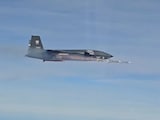American space agency NASA has reported about an unusually bright and long-lasting pulse of high energy radiation that passed across the Earth on October 9. It said that the source of the radiation was gamma-ray burst (GRB), one of the most energetic and luminous electromagnetic explosions. In a release posted on its website, NASA said that the GRB was detected by Fermi Gamma-ray Space Telescope, Neil Gehrels Swift Observatory and Wind spacecraft. The space agency called the event the GRB 221009A, which marked the beginning of its Fermi Symposium in South Africa's Johannesburg.
"It's safe to say this meeting really kicked off with a bang - everyone's talking about this," Judy Racusin, a Fermi deputy project scientist at NASA's Goddard Space Flight Centre in Maryland, was quoted as saying on the agency's website. Mr Racusin is also attending the conference.
The signal originated from the direction of the constellation Sagitta, and travelled an estimated 1.9 billion years to reach Earth, NASA said.
Astronomers believe it represents the birth cry of a new black hole, one that formed in the heart of a massive star collapsing under its own weight. In these circumstances, a nascent black hole drives powerful jets of particles traveling near the speed of light.
Another GRB this bright may not appear for decades, the space agency further said.
"This burst is much closer than typical GRBs, which is exciting because it allows us to detect many details that otherwise would be too faint to see," said Roberta Pillera, a Fermi LAT Collaboration member who led initial communications about the burst and a doctoral student at the Polytechnic University of Bari, Italy. "But it's also among the most energetic and luminous bursts ever seen regardless of distance, making it doubly exciting."
According to NASA's preliminary analysis, Fermi's Large Area Telescope (LAT) detected the burst for more than 10 hours.















